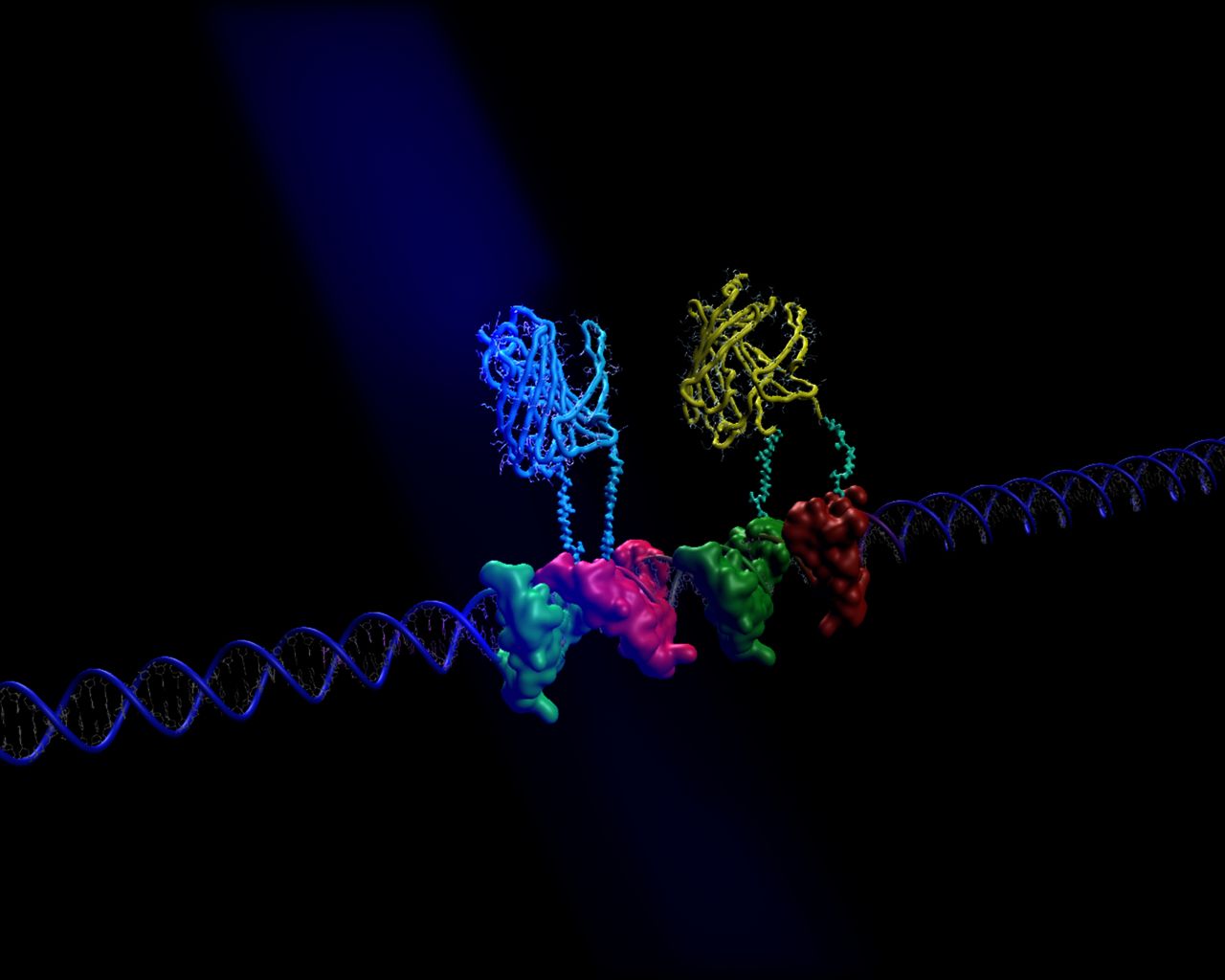Team:Slovenia/PROJECT/proof/popfret/back
From 2010.igem.org
A green fluorescent protein (GFP), first isolated in the 60s from a jellyfish Aequorea victoria, has been mutated in many different ways leading to a wide variety of fluorescent proteins with novel fluorescent properties.
It has been shown (Segal et al., 2005), that after splitting a fluorescent protein in two parts and fusing them with DNA specific binding domains, they can be brought together by the addition of a DNA containing specific DNA binding motifs for both DNA binding domains, leading to reconstitution and maturation of a functional fluorescent protein. It has also been reported than an amino acid overlap at the stitching point of split protein accelerates and enhances protein reassembly (Kerppola et al., 2003). We further developed this concept by testing split GFP reconstitution on a DNA program sequence leading to FRET effect in vivo thereby proving sequential binding of as much as four DNA binding factors on a predefined DNA program.
FRET (Förster resonance energy transfer) is a well known biophysical phenomena describing non-radiative energy transfer between two fluorophores. For FRET to occur two conditions have to be fullfield. Firstly, fluorophores must have overlapping fluorescence emission (donor fluorophore) and excitation (acceptor fluorophore) spectra and secondly, donor and acceptor fluorophore have to be close enough, meaning at angstrom range, so that non-radiative energy transfer can occur. Many suitable pairs among fluorescent proteins can be found that are convenient for FRET experiments. mCerulean (cyan fluorescent protein, CFP) and mCitrine (yellow fluorescent protein, YFP) are two among them being especially suitable for FRET studies.
This phenomena is used in a variety of molecular biology techniques, mainly for studying protein-protein interactions since FRET is a function of distance separating fluorescent proteins. This dependance can be simply illustrated as follows: if you double the distance between donor and acceptor molecule, FRET efficiency will be 64-times lower. This relationship is exactly represented as follows:
where E represents the fraction of energy transfer per donor excitation event, r is the distance between donor and acceptor molecule and R0 Förster distance (the distance at which FRET efficiency between two adjacent molecules is 50%).
In our experiments we used a following FRET pair: mCerulean (CFP) and mCitrine (YFP). The donor, CFP, was excited with a 458-nm Argon laser and detected at 470–500 nm. An acceptor, YFP, was excited with a 514-nm Argon laser and detected at 520 to 580 nm window. The emission spectra of donor CFP overlaps with the acceptor YFP excitation spectra, which is sufficient for FRET when both fluorophores are close to each other. The FRET is detected as light emitted from acceptor only when donor was excited first. An acceptor photobleaching is used to confirm that we observe the FRET effect in cells. The de-quenching of the donor upon photo-destructing the acceptor results in an increase of the donor fluorescence, which is proportional to the FRET efficiency E.
A completely novel feature of our project is the observation of FRET in vivo as a consequence of sequential binding of 4 different fusion proteins carrying split GFP part linked to a DNA binding factor: Gli1_link_nCFP (BBa_K323021), cCFP_link_HIVC (BBa_K323029) reconstituting fully functional CFP, and two others, PBSII_link_nYFP (BBa_323005) and cYFP_link_Zif268 (BBa_323080), leading to YFP reassembly. First two DNA binding domains were selected from Registry of Parts (Gli1 and ZNF_HIVC) and were successfully upgraded by the addition of split fragments of fluorescent proteins. Selection of constructs for testing FRET in vivo in this way was based according to the predefined DNA program shown below (BBa_323039):
Experimental results are based on 4 functional split constructs cloned into the CMV + pSB1AK8 vector previously designed by Slovenian iGEM teams along with a DNA program sequence cloned into pSB1C3.
What is the basis for the FRET effect in our system?
After transfection of chimeric proteins of split GFP linked to zinc fingers under the control of a constitutive CMV promoter, proteins are expressed in mammalian HEK293 cell line. Zinc fingers bind to their target elements on the contransfected DNA program. Initially, these bring together pairs of split GFPs to form mature functional fluorophore. When functional fluorescent proteins are reassembled, the system is ready to FRET, which happens after 24 hour maturation time in vivo.
[1] Hu C. D., Kerpolla K. T. 2003. Simultaneous visualization of multiple protein interactions in living cells using multicolor fluorescence complementation analysis. Nature Biotechnology. 21: 539-545
[2] Segal et al. 2005. DNA Sequence-Enabled Reassembly of the green fluorescent protein. Journal of the Americal Chemical Society. 31: 10782-10783
 "
"

